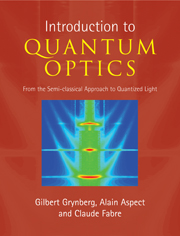Book contents
- Frontmatter
- Contents
- Foreword
- Preface
- Acknowledgements
- Part I Semi-classical description of matterlight interaction
- 1 The evolution of interacting quantum systems
- Complement 1A: A continuum of variable width
- Complement 1B: Transition induced by a random broadband perturbation
- 2 The semi-classical approach: atoms interacting with a classical electromagnetic field
- Complement 2A: Classical model of the atom-field interaction: the Lorentz model
- Complement 2B: Selection rules for electric dipole transitions. Applications to resonance fluorescence and optical pumping
- Complement 2C: The density matrix and the optical Bloch equations
- Complement 2D: Manipulation of atomic coherences
- Complement 2E: The photoelectric effect
- 3 Principles of lasers
- Complement 3A: The resonant Fabry–Perot cavity
- Complement 3B: The transverse modes of a laser: Gaussian beams
- Complement 3C: Laser light and incoherent light: energy density and number of photons per mode
- Complement 3D: The spectral width of a laser: the Schawlow–Townes limit
- Complement 3E: The laser as energy source
- Complement 3F: The laser as source of coherent light
- Complement 3G: Nonlinear spectroscopy
- Part II Quantum description of light and its interaction with matter
- Part III Applying both approaches
- Index
Complement 3E: The laser as energy source
Published online by Cambridge University Press: 05 August 2012
- Frontmatter
- Contents
- Foreword
- Preface
- Acknowledgements
- Part I Semi-classical description of matterlight interaction
- 1 The evolution of interacting quantum systems
- Complement 1A: A continuum of variable width
- Complement 1B: Transition induced by a random broadband perturbation
- 2 The semi-classical approach: atoms interacting with a classical electromagnetic field
- Complement 2A: Classical model of the atom-field interaction: the Lorentz model
- Complement 2B: Selection rules for electric dipole transitions. Applications to resonance fluorescence and optical pumping
- Complement 2C: The density matrix and the optical Bloch equations
- Complement 2D: Manipulation of atomic coherences
- Complement 2E: The photoelectric effect
- 3 Principles of lasers
- Complement 3A: The resonant Fabry–Perot cavity
- Complement 3B: The transverse modes of a laser: Gaussian beams
- Complement 3C: Laser light and incoherent light: energy density and number of photons per mode
- Complement 3D: The spectral width of a laser: the Schawlow–Townes limit
- Complement 3E: The laser as energy source
- Complement 3F: The laser as source of coherent light
- Complement 3G: Nonlinear spectroscopy
- Part II Quantum description of light and its interaction with matter
- Part III Applying both approaches
- Index
Summary
We have seen in the present chapter that the light emitted by a laser has properties that are radically different from those of the light emitted by classical sources. These properties have been the basis for the myriad applications found for lasers since their advent in the 1960s; they have escaped the confines of the research laboratory to become ubiquitous in industrial production and modern consumer society. Lasers now have innumerable applications in such disparate areas as medicine, metallurgy and telecommunications and are at the heart of new developments in commercial and consumer electronics (CD and DVD players, bar-code readers and printers, to name but a few examples).
The total market in the mid 2000s was estimated to be almost 6 billion dollars. It was dominated by the domains of optical storage (30% of the total amount) and communication (20%), which are mass production markets. In contrast, material processing (25%) and medical applications (8%) involve a smaller number of very expensive lasers. Research and instrumentation amount to 6% of the total sales. The significant fraction of laser sales related to research and development is a testament to the relative youth of the technology. New applications are still coming to light, some of which may have profound economic consequences for the future.
It will not be possible to provide an exhaustive account of these applications here. We shall, therefore, concentrate on a few significant examples selected from the broad categories introduced above.
- Type
- Chapter
- Information
- Introduction to Quantum OpticsFrom the Semi-classical Approach to Quantized Light, pp. 261 - 270Publisher: Cambridge University PressPrint publication year: 2010



